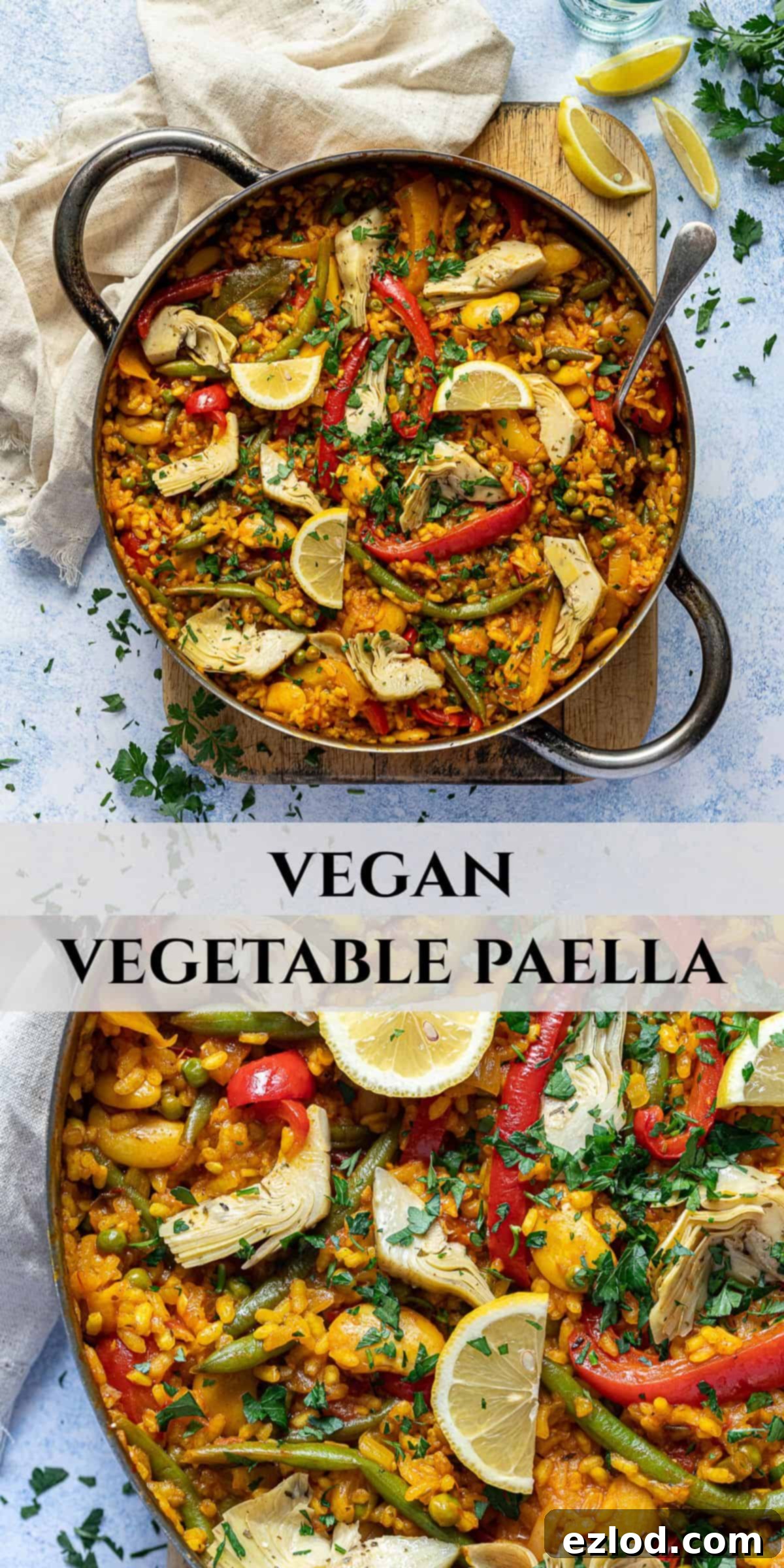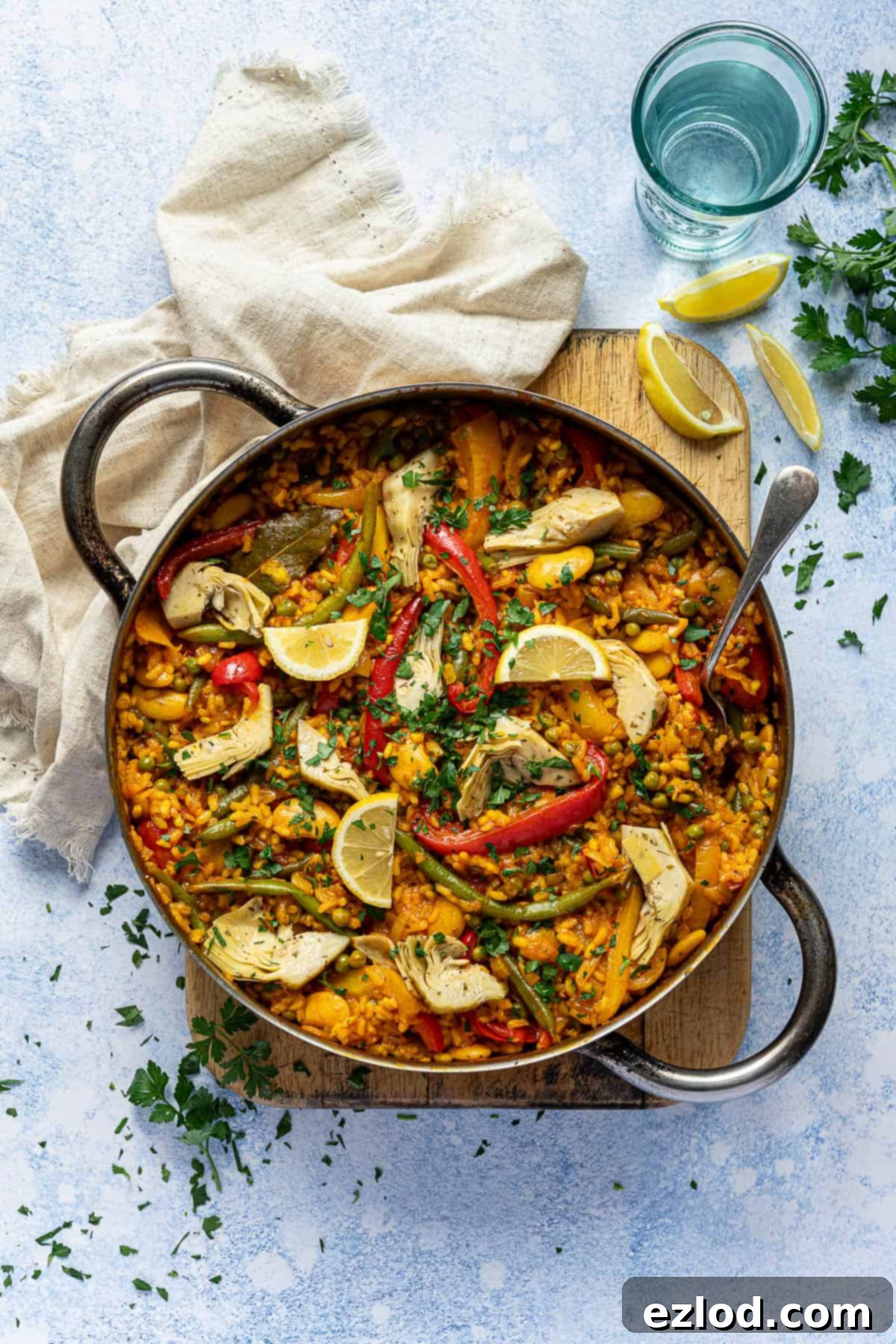Delicious & Easy Vegan Vegetable Paella: A One-Pan Spanish Delight
Embark on a culinary journey to Spain with this incredible vegan vegetable paella (paella de verduras). It’s an easy, one-pan meal that looks incredibly impressive yet is surprisingly simple to create. Bursting with fresh vegetables and infused with rich, aromatic flavors, this hearty and delicious plant-based paella is perfect for entertaining or a comforting weeknight dinner.
Inspired by the traditional flavors of Spanish paella, this recipe artfully ditches the meat and seafood, focusing instead on a generous abundance of vibrant vegetables. The result is a healthy, satisfying, and deeply flavorful meal that caters to vegan diets and is naturally gluten-free (just ensure your vegetable stock is certified gluten-free), making it suitable for everyone at the table!
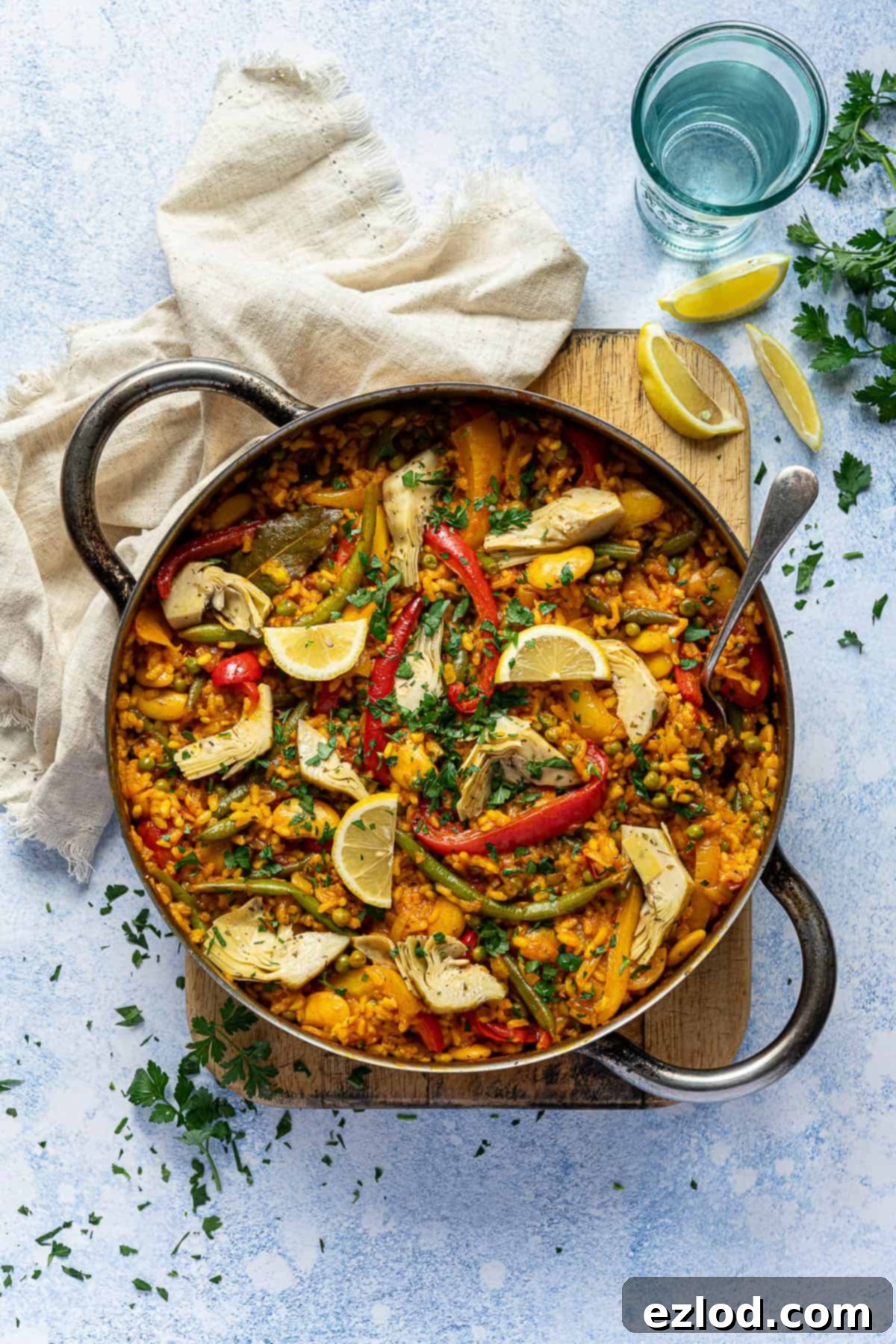
Essential Ingredients for Your Vegan Vegetable Paella:
Creating an authentic and incredibly flavorful vegan paella relies on a few key ingredients. While this recipe is flexible with the choice of vegetables, we highly recommend not omitting or substituting the core components for the best possible taste and texture.
- Paella Rice (Bomba Rice): This is the star of any paella. Bomba rice, a short-grain Spanish variety, is highly prized for its unique ability to absorb a large amount of liquid and flavor without becoming mushy. This characteristic is crucial for achieving the perfect paella texture, where individual grains remain distinct yet tender, and contribute to the coveted “socarrat.” We strongly advise against using basmati, long-grain, or brown rice as they will yield an entirely different result. In a pinch, risotto rice could work, but your paella might lean towards a creamier, risotto-like consistency rather than the distinct, drier grains typical of paella.
- High-Quality Olive Oil: Traditionally, paella contains a generous amount of olive oil, and for good reason. It forms the flavor base, allowing the aromatics to gently soften and release their essence, and also contributes to the rich, golden hue and mouthfeel of the finished dish. We do not recommend reducing the amount, as it plays a vital role in both flavor and texture.
- Saffron: The jewel of paella spices, saffron is what gives the dish its iconic golden-orange color and distinct, subtly floral, and earthy fragrance. While it can be a pricey ingredient, a small amount goes a long way, and its unique flavor profile is truly irreplaceable for an authentic paella experience. If you must, a tiny pinch of turmeric can mimic the color, but it won’t replicate saffron’s complex aroma.
- Smoked Paprika (Pimentón Ahumado): This spice is essential for adding a wonderful smoky depth and characteristic Spanish flavor to your paella. Opt for a good quality Spanish smoked paprika (dulce for sweet, agridulce for semi-sweet, or picante for hot, depending on your preference).
- Dry White Wine: A splash of dry white wine deglazes the pan, lifting up flavorful bits, and provides a fantastic acidic and aromatic base for the paella. Always ensure that the wine you choose is vegan-friendly; many brands are, but some may use animal products in the fining process.
- Fresh & Dried Herbs: We incorporate a blend of thyme, rosemary, bay leaves, and fresh parsley into our vegan vegetable paella. These herbs infuse the rice with a complex, savory aroma. Feel free to experiment with other Mediterranean herbs like oregano or marjoram if you desire, but this combination provides a classic and harmonious flavor.
- Aromatics (Tomatoes, Onion, Garlic): These humble ingredients form the essential “sofrito,” the aromatic foundation of paella. Gently cooking diced tomatoes, finely chopped onion, and crushed garlic creates a sweet, savory, and umami-rich base that permeates the entire dish.
- Quality Vegetable Stock: The flavor of your stock significantly impacts the overall taste of your paella. Use a good quality vegetable bouillon, or even better, a homemade vegetable broth for the richest flavor. We prefer a robust bouillon like Marigold, prepared slightly stronger than usual to ensure the rice absorbs maximum flavor. You may need to have a little extra stock or water on hand; use the initial amount specified, and if the rice is still too firm after all liquid is absorbed, add a splash more until it reaches al dente perfection.
- Lemon: A squeeze of fresh lemon juice added right at the end of cooking brightens all the flavors and adds a welcome zest. You can also simply serve the paella with lemon wedges, allowing everyone to add their desired amount.
- Vibrant Vegetables: Our chosen mix includes colorful bell peppers (red and yellow), tender green beans, sweet green peas, and tangy jarred artichoke hearts for a delightful variety of textures and tastes. For a protein boost, we add hearty butter beans, but chickpeas or pre-cooked vegan chicken-style pieces (cooked separately and stirred in at the end) also work wonderfully. Feel free to customize with other vegetables like asparagus, mushrooms, or zucchini. Keep in mind that denser or harder vegetables like butternut squash or fennel may need to be roasted or sautéed separately until nearly tender before being added to the paella.
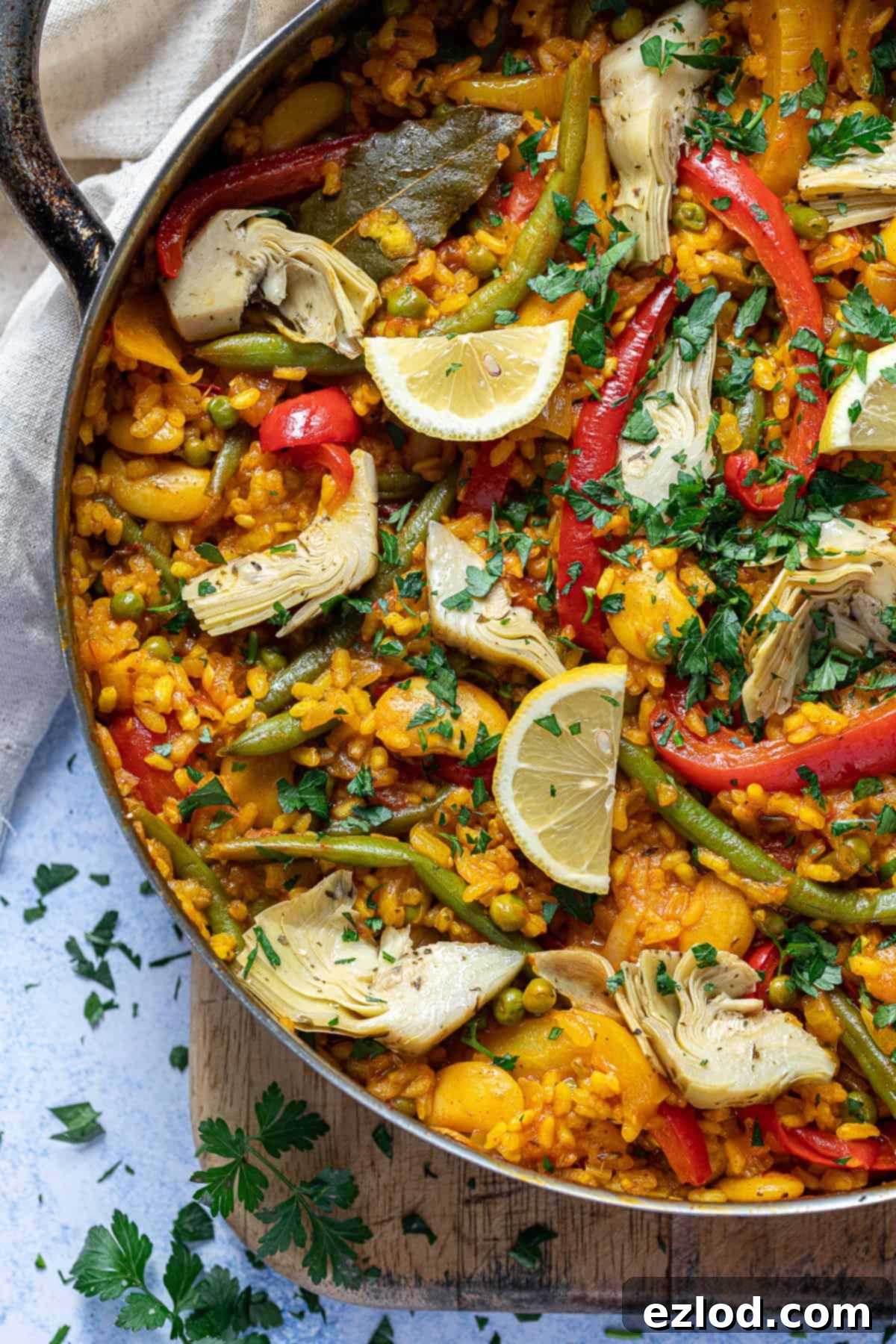
How to Prepare Your Delicious Vegan Vegetable Paella:
(For precise measurements and detailed step-by-step instructions, please refer to the recipe card located at the bottom of this page.)
Begin by combining your vegetable stock with the precious saffron strands in a jug. Give it a gentle stir and set it aside to allow the saffron to infuse its color and aroma into the liquid. This simple step ensures maximum saffron flavor distribution throughout your paella.
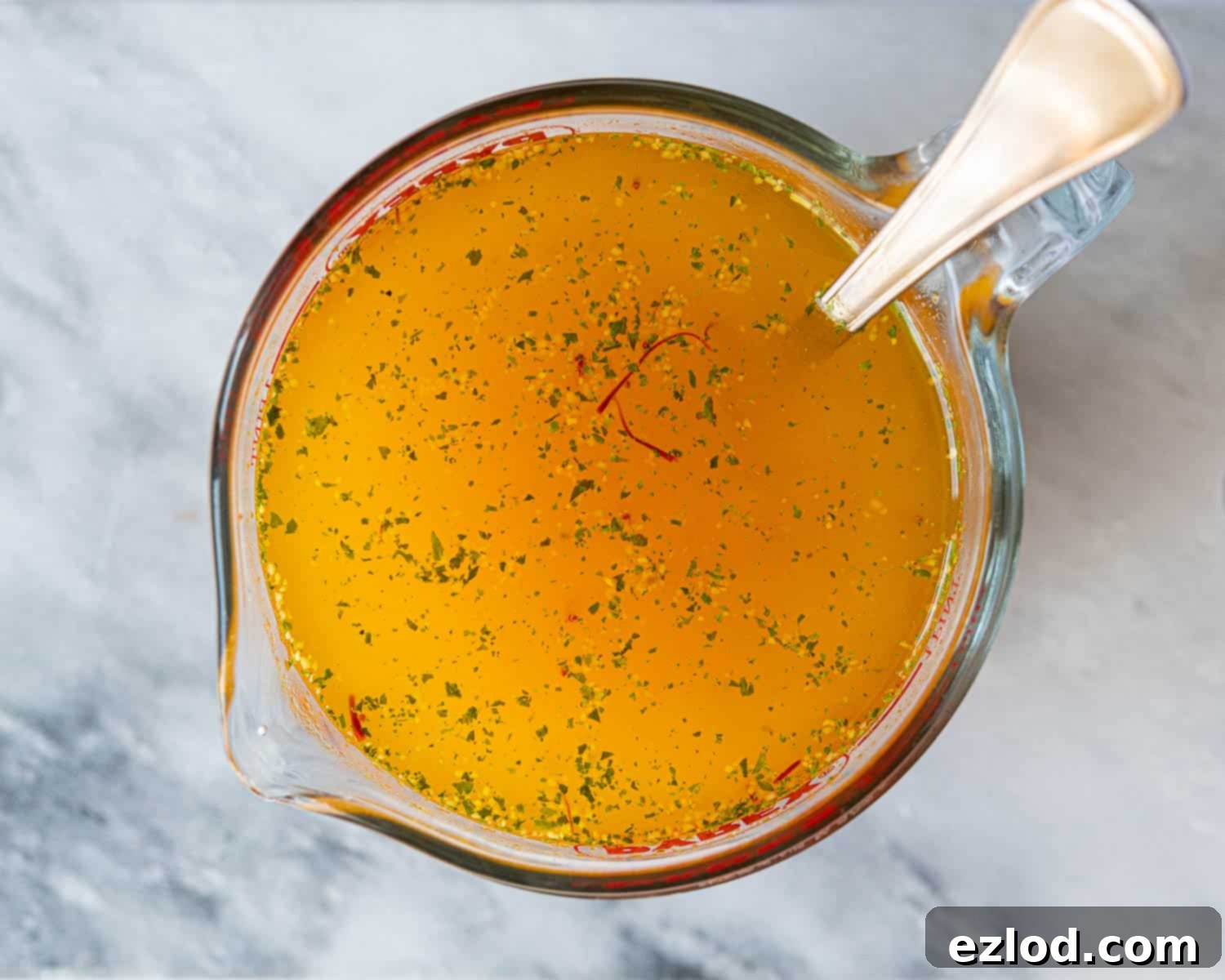
Next, heat the olive oil in a large, wide paella pan or a wide, heavy-bottomed skillet over a low heat. Add the finely chopped onion and sauté gently for about 10 minutes, or until it becomes translucent and soft, but not browned. This slow cooking extracts maximum sweetness from the onion.
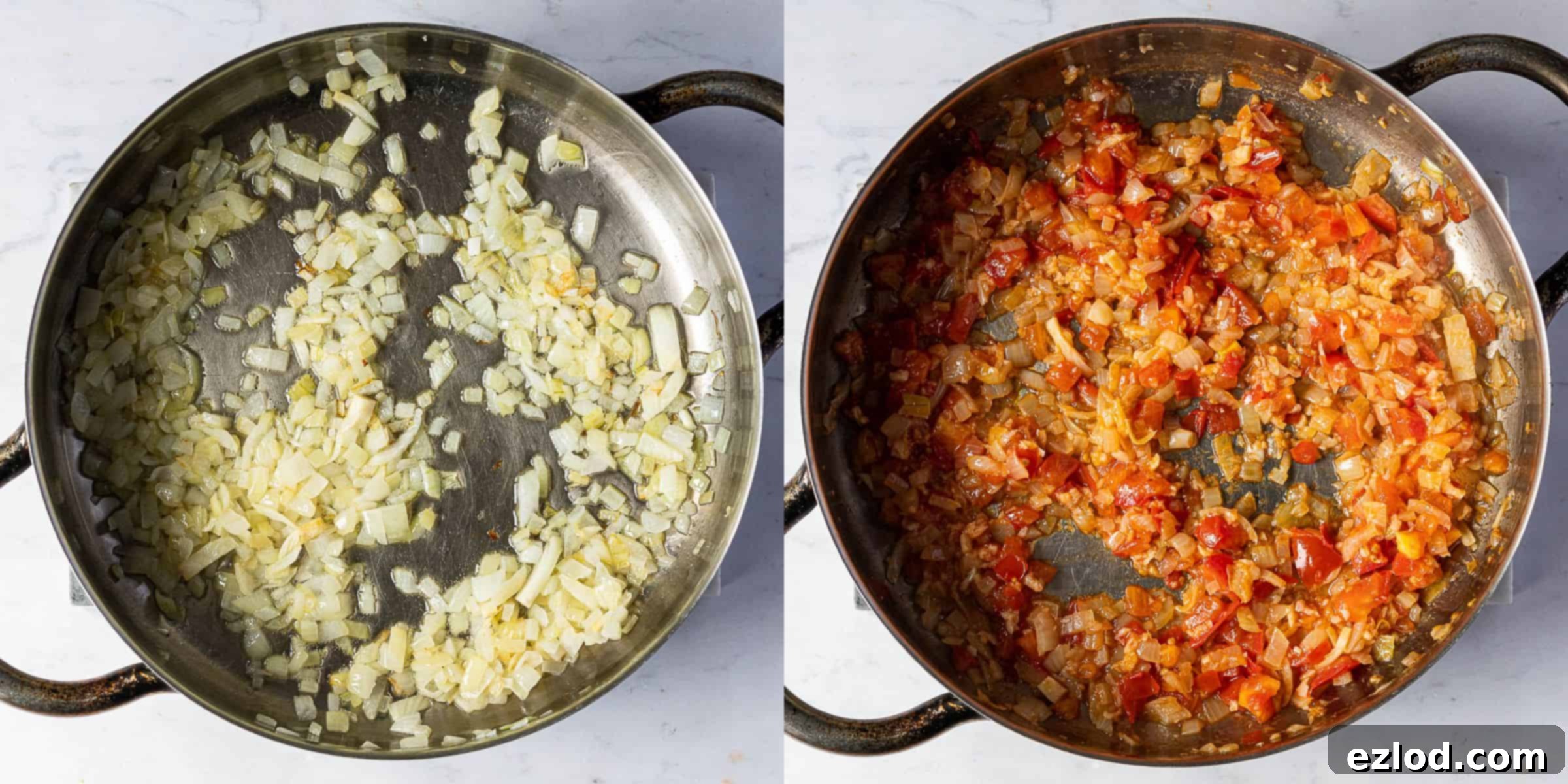
Stir in the diced tomatoes and crushed garlic. Continue to cook gently for another 5-10 minutes. The tomatoes should soften and break down, merging with the onion to form a rich aromatic base – the heart of your paella’s flavor.
Now, add the sliced bell peppers, smoked paprika, bay leaves, dried thyme, dried rosemary, and tomato puree to the pan. Sauté for a further 2 minutes, stirring gently, to allow the spices to bloom and release their full fragrance.
Pour in the white wine. Increase the heat slightly and let it simmer until almost all of the liquid has evaporated. This process, known as deglazing, concentrates the wine’s flavor and helps scrape up any delicious browned bits from the bottom of the pan.
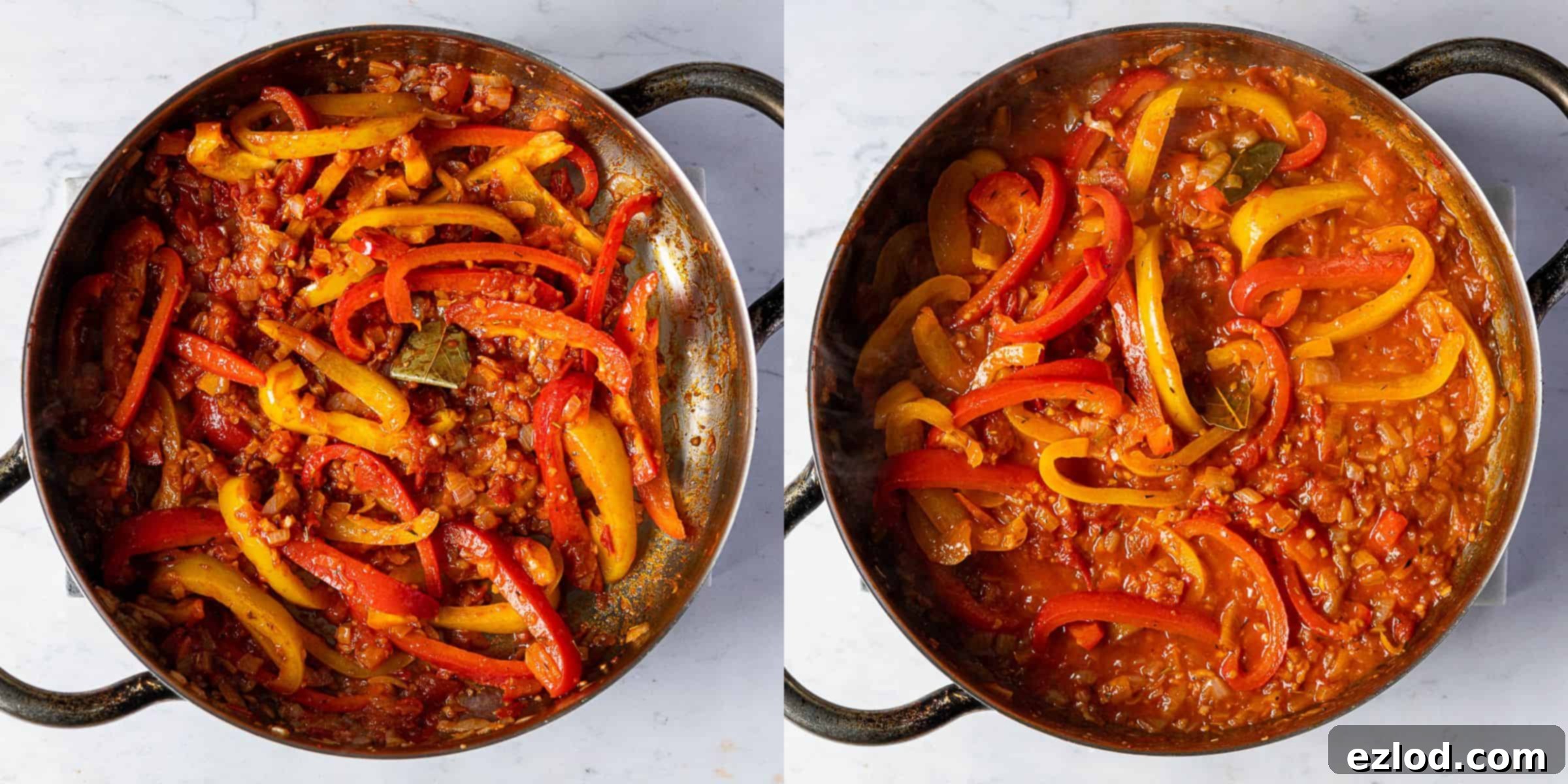
Add the paella rice, green beans, peas, drained butter beans, and your saffron-infused stock mixture to the pan. Stir everything gently just until it is well combined and the rice is evenly distributed. Then, reduce the heat to a gentle simmer and cook undisturbed for approximately 20 minutes, or until the stock has been mostly absorbed by the rice.
Crucially, resist the urge to stir the paella once the rice has been added and the liquid is simmering. Constant stirring, as you would with risotto, will release starches and result in a creamy, rather than distinct, grain texture. To ensure even cooking, simply rotate the pan occasionally.
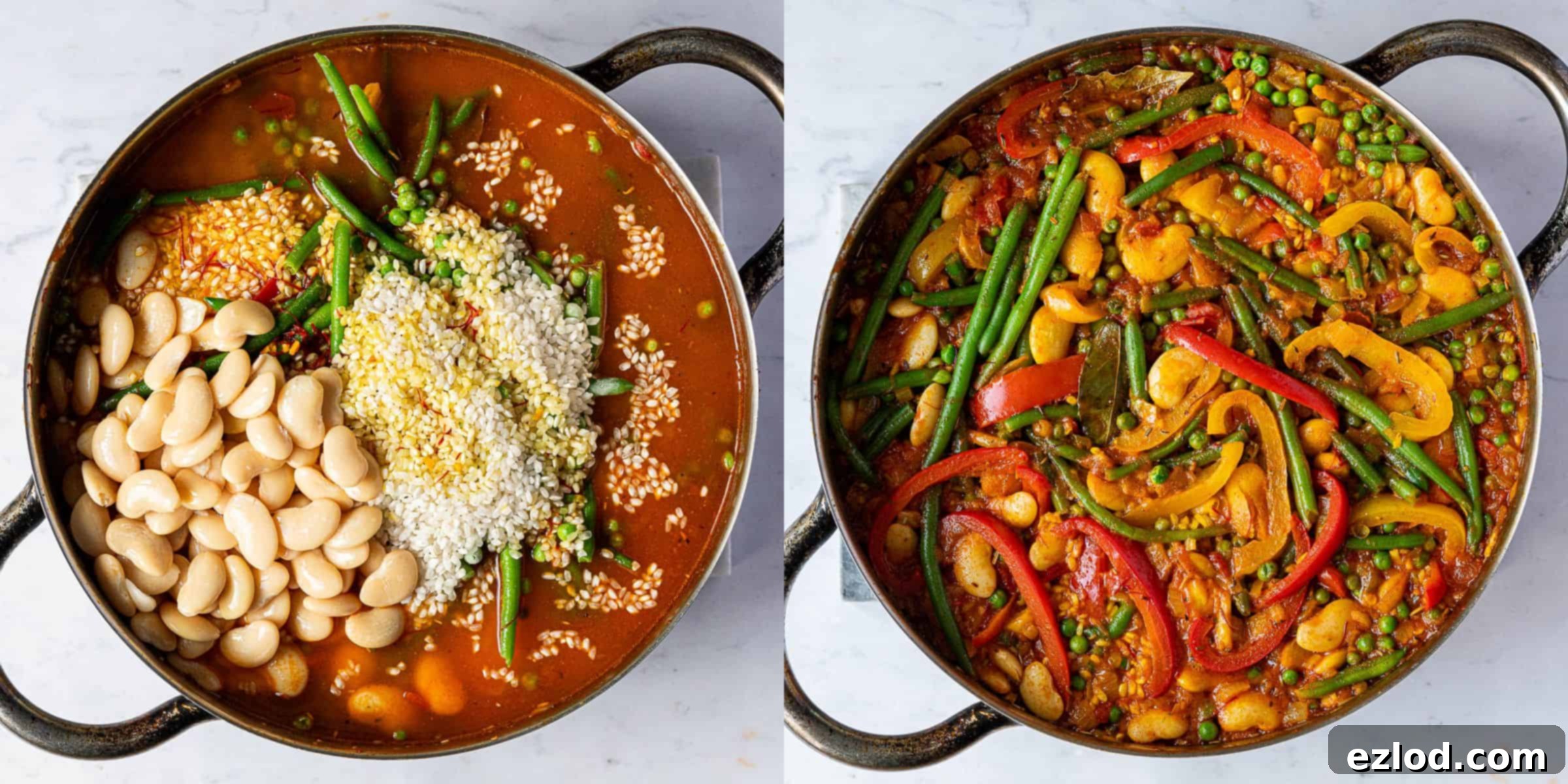
After about 20 minutes, give the paella a very brief, gentle stir to check the rice. Taste a grain; if it’s still too firm, drizzle a little more stock or water over the top and continue cooking on a low heat until the rice is just al dente, tender with a slight bite.
For the highly sought-after “socarrat” – the delicious crispy, caramelized layer of rice at the bottom of the pan – turn up the heat slightly for the last few minutes of cooking. Listen carefully for a gentle crackling sound and a distinct toasted aroma. As soon as you hear it, remove the pan from the heat. Be very cautious during this step, as it can quickly go from perfect to burnt! This step is entirely optional but adds an incredible depth of flavor and texture that many paella enthusiasts adore.
Finally, season the paella to taste with salt, black pepper, and a generous squeeze of fresh lemon juice. Arrange the drained artichoke hearts artfully on top of the cooked rice. Cover the pan tightly with a lid or a sheet of tin foil and let it rest for 10-15 minutes off the heat. This resting period allows the flavors to meld beautifully and the rice to finish steaming perfectly.
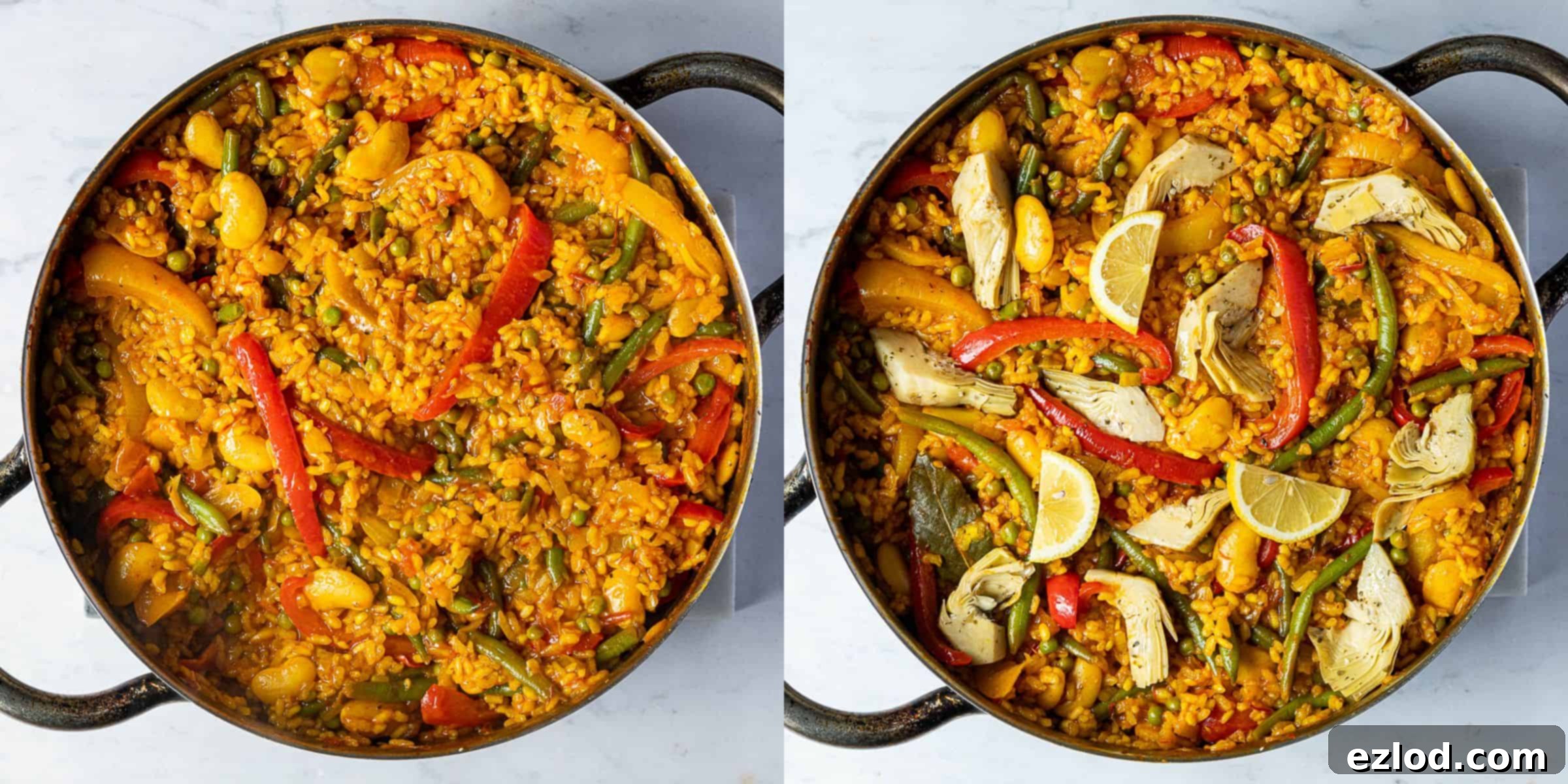
Serve your beautiful vegan vegetable paella immediately, garnished with freshly chopped parsley and extra lemon wedges for a burst of freshness.
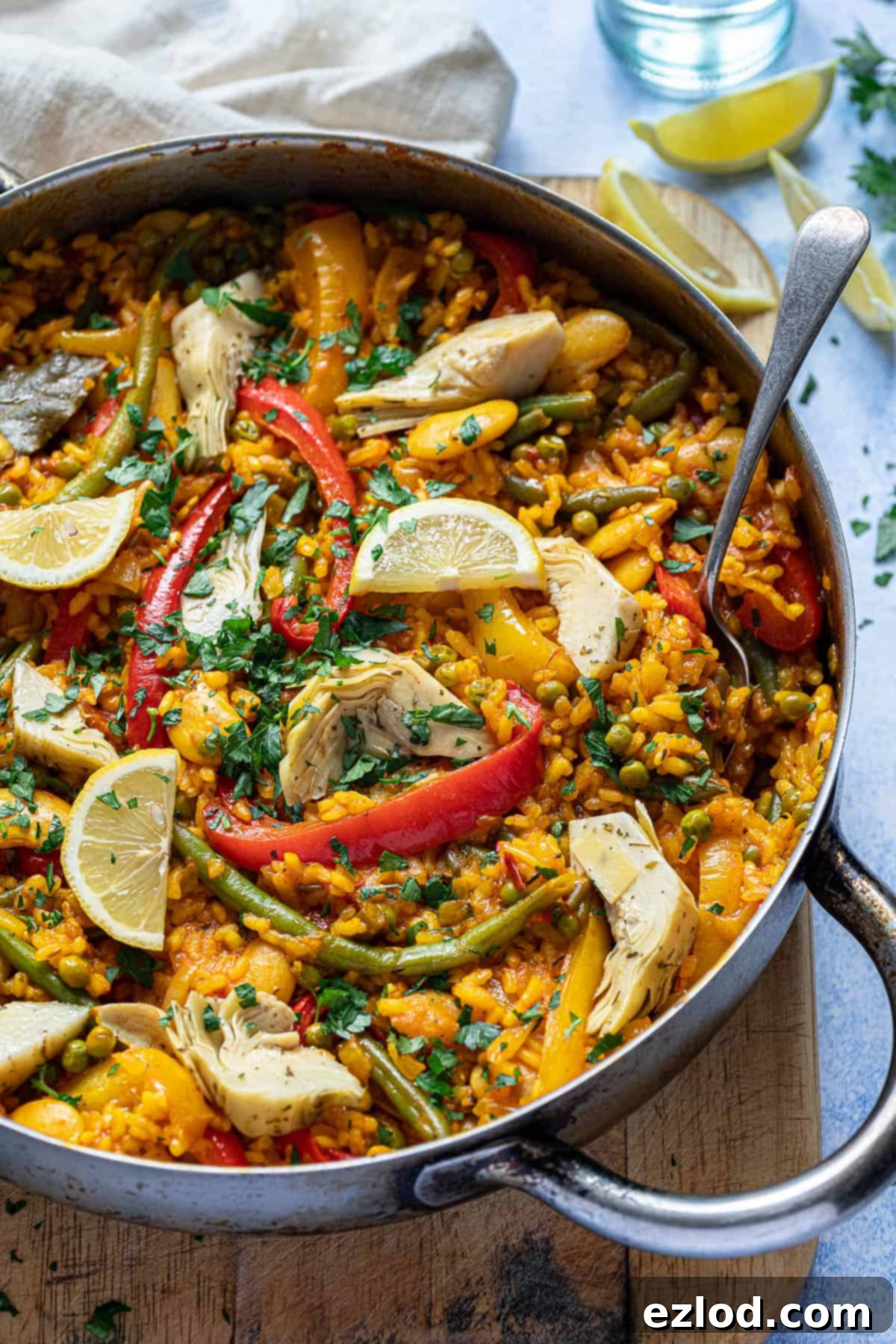
Top Tips for Perfect Vegan Paella:
- Adhere to the Recipe: For the most authentic and delicious results, we highly recommend following this recipe closely. Each ingredient plays a specific role in developing the complex flavor profile of the paella, and omitting any may lead to a less satisfying outcome.
- Season Generously: Don’t underestimate the power of proper seasoning. A good balance of salt and pepper can elevate the flavors significantly. Taste and adjust as needed before the final rest.
- Embrace Olives: For an extra layer of briny, savory flavor, feel free to add about 75g of pitted green or black olives along with the other vegetables. They complement the Spanish profile beautifully.
- Boost with Vegan Chorizo: If you’re looking for an extra punch of flavor and heartiness, consider adding some vegan chorizo-style sausages. Chop them into pieces, fry them separately until slightly crispy, and then stir them into the paella at the very end of cooking, just before resting.
- The Right Pan Matters: Paella is ideally cooked in a traditional paella pan, which is very wide and shallow. This design ensures the rice cooks in a thin layer, promoting even absorption of liquid and maximizing the surface area for the coveted “socarrat.” If you don’t own a paella pan, a large, wide cast-iron skillet or a wide stainless steel pan with a heavy bottom makes an excellent substitute. The key is a wide, shallow surface.
- No Stirring Rule: This is perhaps the most crucial rule for paella! Unlike risotto, paella should NOT be stirred once the rice and liquid are combined and simmering. Stirring releases starch, resulting in a creamy, sticky texture instead of distinct, perfectly cooked grains. Resist the urge!
Storage and Reheating Advice:
While this vegan vegetable paella is undeniably best enjoyed freshly cooked, any leftovers can be stored and reheated.
- Refrigeration: Leftover paella will keep well in an airtight container in the fridge for up to 3 days. It is critical to transfer the paella to the fridge as soon as it has cooled down to room temperature. Cooked rice should never be left at room temperature for extended periods due to potential food safety risks.
- Freezing: For longer storage, this paella can also be frozen in a freezer-proof container for up to 1 month. Again, ensure it is cooled and frozen as quickly as possible after cooking.
- Reheating: To reheat, simply warm thoroughly in the microwave or on the stovetop over low heat with a splash of water or stock. Ensure the paella is piping hot all the way through before serving.
More Hearty Vegan Meals to Explore:
If you loved this vegan paella, you might also enjoy these other satisfying plant-based dishes:
- Vegan Swedish meatballs
- Vegan mushroom risotto with truffle oil
- Chickpea, leek and mushroom pie
- Vegan chicken potato pie
- Vegan mushroom and tofu korma
- Creamy vegan mushroom pasta with truffle oil
- Creamy vegetable chickpea soup
- Vegan cottage pie
- Vegan chilli cornbread pie
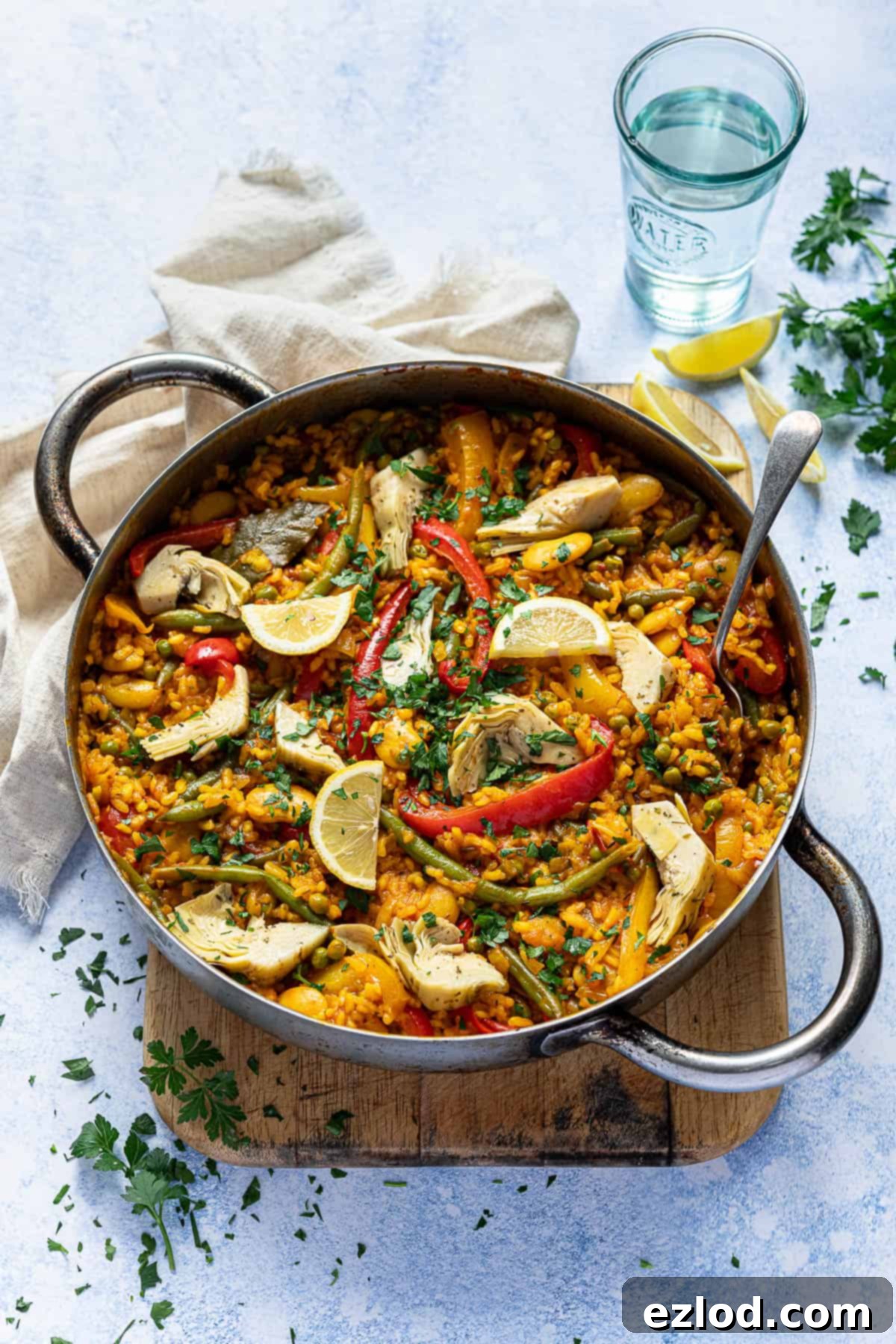
We hope you enjoyed making this delightful vegan vegetable paella! If you tried this recipe, we’d love to hear from you. Please rate it, leave a comment below, or tag @domestic_gothess on Instagram and hashtag it #domesticgothess to share your creation!
All images and content on Domestic Gothess are copyright protected. If you wish to share this recipe, please do so by using the provided share buttons. Kindly do not screenshot or repost the recipe or content in full; instead, include a direct link to this post for the complete recipe details. Your support is greatly appreciated!

Print
Vegan Vegetable Paella
Ingredients
- 1 packed teaspoon saffron threads
- 700 ml (3 cups) vegetable stock (made with 4 teaspoons of Marigold bouillon, or similar quality) plus extra as needed for cooking
- ½ teaspoon salt
- 60 ml (¼ cup) good quality olive oil
- 1 large brown onion finely chopped
- 2 medium/large ripe tomatoes (about 270g) diced
- 6 cloves fresh garlic peeled and crushed
- 1 red bell pepper sliced into thin strips
- 1 yellow bell pepper sliced into thin strips
- 2 slightly rounded teaspoons smoked paprika
- 2 bay leaves
- ½ teaspoon dried rosemary
- ½ teaspoon dried thyme
- 1 Tablespoon tomato puree (paste)
- 240 ml (1 cup) dry white wine (vegan-friendly)
- 300 g (1 ½ cups) paella rice (Bomba recommended)
- one 400g (14 oz) tin butter beans drained and rinsed
- 170 g (6 oz) fresh or frozen green beans trimmed and halved if large
- 150 g (1 cup) frozen peas
- juice of ½-1 fresh lemon to taste
- 100 g (3 ½ oz) jarred artichoke hearts drained and quartered
- salt and freshly ground black pepper to taste
- chopped fresh parsley for serving
Instructions
-
In a medium jug or bowl, combine the saffron threads with the vegetable stock and ½ teaspoon of salt. Stir gently and set aside to infuse while you prepare the other ingredients.
-
Heat the olive oil in a large, wide paella pan or heavy-bottomed skillet over a low heat. Add the finely chopped onion and cook gently for about 10 minutes, stirring occasionally, until it is very soft and translucent. Avoid browning.
-
Add the diced tomato and crushed garlic to the pan. Continue to cook gently for another 5-10 minutes, stirring occasionally, until the tomatoes have softened and broken down, forming an aromatic base.
-
Stir in the sliced bell peppers, smoked paprika, bay leaves, dried thyme, dried rosemary, and tomato puree. Cook for 2 minutes, stirring to ensure the spices are fragrant and well combined with the vegetables.
-
Pour in the white wine. Increase the heat to medium-high and simmer, stirring occasionally, until almost all of the wine has evaporated and reduced, leaving behind a concentrated flavor.
-
Add the paella rice, green beans, peas, drained butter beans, and the saffron-infused stock mixture to the pan. Stir everything gently once or twice to ensure the rice and vegetables are evenly distributed. Reduce the heat to a gentle simmer and cook for approximately 20 minutes, or until the liquid has been absorbed. Do not stir the paella while it is cooking from this point onward. To ensure even cooking, you may occasionally rotate the pan.
-
Give the paella a brief, very gentle stir to assess the rice. Taste a grain to check for doneness. If the rice is still too firm, drizzle a bit more stock or hot water over the top and continue to cook over a low heat until the rice is just al dente (tender with a slight bite).
-
To achieve the coveted crispy rice base, known as “socarrat,” turn the heat up slightly for the last few minutes of cooking. Listen for a gentle crackling sound and a toasty aroma. Once achieved, immediately remove the pan from the heat. Be very careful not to burn the paella; this step requires close attention. While not strictly necessary, it adds a delicious textural element.
-
Season the paella to taste with additional salt, pepper, and a generous squeeze of fresh lemon juice. Arrange the drained artichoke hearts evenly over the top of the rice. Cover the pan tightly with a lid or aluminum foil and let it rest off the heat for 10-15 minutes. This resting period allows the flavors to meld and the rice to finish steaming to perfection. Garnish with fresh parsley before serving.
Notes
- See the post above for step-by-step photos and additional details to guide you.
- For the best possible results and authentic flavor, follow the recipe closely and use the ingredients as written. Each component contributes significantly to the final dish.
- Feel free to enhance the flavor by adding about 75g (approximately ½ cup) of pitted green olives along with the rest of the vegetables.
- The ideal pan for paella is a very wide, shallow paella pan. This design promotes even cooking and helps form the desirable crispy rice base. If a paella pan is unavailable, a large, wide cast-iron skillet or a shallow stainless steel pan with a heavy bottom will work as a good alternative. Remember, the wider and shallower, the better.
- Absolutely do NOT stir the paella once the rice has been added and it’s simmering. Stirring will release starches and result in a creamy, risotto-like texture instead of the distinct grains characteristic of paella.
